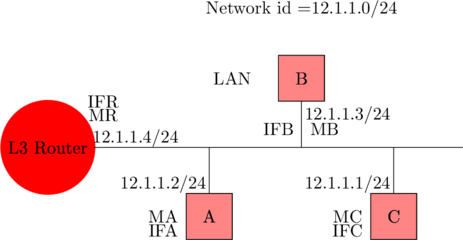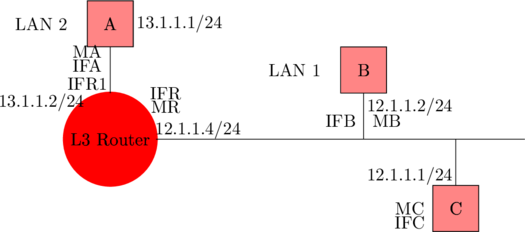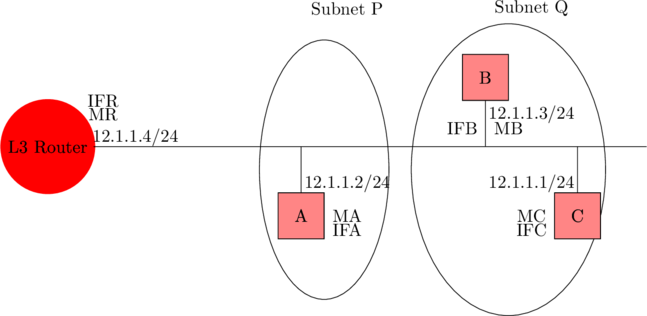Let us understand how VLANs are better than LANs by using a simple topology as mentioned below
As you can see from the below topology that on the left-hand side of an L3 router we have internet connectivity meanwhile on the right-hand side we have a subnet A with network id as 12.1.1.0/24

From the above topology, the L3 router has a physical interface (IFR) which host subnet A, and subnet A host three machines A, B, C
So, when can we say a set of machines are present in local area network(LAN)
A set of machines will be in the local area network when it satisfies two conditions as mentioned below
- All the assigned IP address of machines falls in the same subnet
- All the machines should be connected to the same physical wire
Therefore, we can say that the machines A, B, C from the above topology forms a local area network(LAN)
Why?
Because it satisfies the above two conditions
As you see the host machines A, B, C, are in the same subnet and they are connected to the same physical wire
Remember: LAN is an outdated technology and VLANs has taken over it
# First drawback

The first drawback that we have with LAN is immobility
So, what exactly does that mean?
As you can see from the above topology that we have an L3 router with one physical interface(IFR) which have a subnet whose network id is 12.1.1.0/24, let us call this a local area network
The LAN in the above topology contains three host machines A, B, C
At this instant suppose you would like to place machine A in a different subnet
Is it possible?
If you would like to move machine A into a different subnet then you need to change the IP address (12.1.1.2/24)which is configured on machine A
Suppose if you changed the IP address of machine A to 13.1.1.1/24 then machine A will not fall in the same subnet therefore wrong configuration occurs
So, the only way by which you can move machine A to a different subnet is to move machine A physically
As you can see from the below topology that the machine A has physically moved from LAN1 to LAN2

Moving the machine physically means you need to re-cable the wires to place the machine in a different subnet, And also Re-cabling the network will be a big problem for a network administrator
Moreover, L3 routers are expensive and have a limited no of physical interfaces,
To move the host A into a different subnet you actually consuming one more physical interface of an L3 router
Finally, LANS won’t have the flexibility to move the host machine from one subnet to another subnet without requiring to re-cable the entire network
#second drawback
The second drawback that is associated with LAN is related to security
To explain the drawback of LAN let us consider that govt library is there where regular visitors will arrive some are temporary visitors and some are regular employees of the library who manage the library
So, the problem arises, when all the visitors are connected to the same physical LAN then they would have equal access to library resources unless restrictions are made per user level
Finally, the library management doesn’t like to grand permission or privileges to the resources for temporary visitors which library usually grand to regular employee
Vlans (virtual local area network)
Vlans solves the problem of Lans immobility and security
Moreover, Vlan is a Layer 2 concept that can be implemented by using an L2 switch
Vlans allows different machines which are connected to the same physical wire to reside in a different subnet
So, for example, consider the below topology where Vlan allows machine A to be in subnet P meanwhile the machines B and C reside in a subnet Q

As you can see from the above topology that there is no need to move machine A to another interface of an L3 router and all the machines which are present in the topology can be placed in the different subnet using the concept called Vlans
As we have discussed the security issue of Lan with an example case of a library but certainly we can solve that issue by using Vlans for instance you can host machines B and C with subnet Q for temporary visitors of the library meanwhile machine A with subnet P could be used by the library management team
So, with the help of Vlan both the subnet performs logically different functions


Leave a Reply